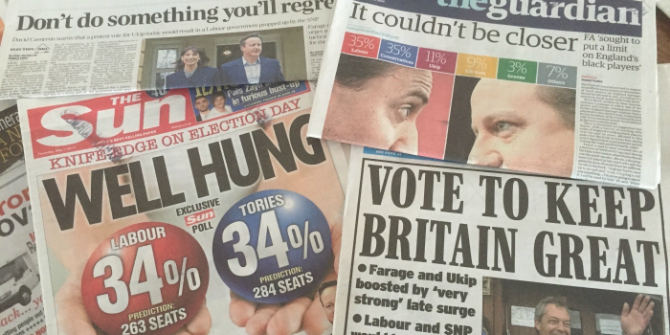 In this post, Niall Hughes argues that FPTP electoral system performs much better in the context of multi-party politics. Crucially, in a general election a voter’s preferred candidate will depend on the results in other constituencies. As a result, when three parties compete in a general election and voters care about national policy, the problem of polarisation under FPTP is mitigated.
In this post, Niall Hughes argues that FPTP electoral system performs much better in the context of multi-party politics. Crucially, in a general election a voter’s preferred candidate will depend on the results in other constituencies. As a result, when three parties compete in a general election and voters care about national policy, the problem of polarisation under FPTP is mitigated.
In any election the outcome is strongly influenced by the voting rule used. The UK elects its parliament in a series of 650 First-Past-The-Post (FPTP) constituency elections, though there are many other voting rules to choose from, each with their own costs and benefits. Previous articles in this blog have discussed how the FPTP benefits Labour and the Conservatives to the detriment of other parties. Others have claimed that FPTP is no longer suitable given the rise of multi-party politics in the UK and that perhaps the 2015 election will reignite the debate over electoral reform. What’s more, FPTP has recently been deemed the worst voting rule by a panel of voting theorists. With such a bad reputation it’s a wonder that British voters decided to stick with FPTP in when asked in the 2011 referendum.
This article argues that the much maligned FPTP rule is not at all as bad as commentators frequently make out. My defence of FPTP has nothing to do with a propensity to deliver stable, single party governments (as others rightly point out, there is nothing in FPTP which should deliver a two-party system). Instead, FPTP performs much better than traditional theory suggests because of the rise of multi-party politics and the coalition governments that come with it. The key is in understanding the subtle difference between a single FPTP election and a parliamentary election made up of 650.
Single district FPTP elections
FPTP performs well in a single district election when there are only two candidates but poorly when there are more. With two candidates there is no tension between being strategic and sincere – the best thing you can do is vote for your preferred candidate – and the candidate preferred by the majority wins. However, with a choice of three candidates, voters must consider how others will vote when deciding on their own ballot choice. When faced with choice of three options, voters who prefer the candidate expected to come third have an incentive to abandon him and instead vote for their second favourite. This leaves only two “serious” candidates. This effect is what political scientists call Duverger’s Law – where only two candidates in a FPTP election should receive votes.
What Duverger’s Law doesn’t tell us is which two candidates will receive votes. Anything goes. Voters will vote for the two candidates they believe to be the frontrunners – and this may bear no relation to who the most preferred candidates actually are. Suppose we had a single FPTP election between 3 candidates: one Labour, one Lib Dem and one Conservative; and suppose 5 per cent of voters prefer Labour, 5 per cent prefer the Conservatives and 90 per cent prefer the Lib Dems. If voters believe that Labour and the Conservatives are the serious candidates then the Lib Dems will be deserted by their supporters and we’ll end up with a race between Labour and the Tories. This means that under a single FPTP election, regardless of voter preferences, there can always be polarisation – where a race between the two extreme choices results in the winning policy far away from the centre.
Single district elections v parliamentary elections
However, a UK general election is not a single FPTP election – it is a collection of 650 FPTP elections used to elect a parliament. This might seem like an inconsequential difference but actually the objectives of voters differ significantly in single district elections and general elections.
In a UK general election, once all seats are filled, the elected politicians bargain over the formation of government and then implement policy. If voters care about which policies are implemented in parliament, they will cast their ballots to influence the outcome of this bargaining. So, a voter needs to take into account which alternative governments are the two most likely when casting his vote.
To take an example, in the 2010 election the two most likely outcomes were seen as either an overall Tory majority or a Tory-Lib Dem coalition. Suppose the frontrunners in my constituency are Labour and Tory candidates and suppose I am a voter who identifies as centre-right i.e. I’d prefer a Tory-Lib Dem coalition to a Tory majority. Counterintuitive as it may sound, my best option is to vote for the Labour. By voting Labour rather than Tory in my constituency, I make it less likely that the Tories will get a majority and thus more likely that there’ll be a Tory-Lib Dem coalition government. If instead the most likely national outcomes were between a Labour majority and a Labour-Lib Dem coalition then my best response would be to vote for my local Conservative candidate.
The example above shows that in a general election a voter’s preferred candidate will depend on the results in other constituencies. In contrast, in a standalone FPTP election – such as a mayoral election – a voter’s preference between candidates is fixed. A voter’s preferred mayor does not depend on who wins the mayoral election in another town. These different objectives turn out to be crucial.
My research shows that when three parties compete in a general election and voters care about national policy, the problem of polarisation under FPTP is mitigated. The intuition is as follows. For any party to win a majority of seats in parliament it must be that they are preferred to some alternative by a majority of voters in a majority of districts. I show that the alternative to a Labour majority government will generally not be a Tory majority government (and vice-versa) but rather a moderate coalition government. Therefore, for one of the two traditional UK parties to win an overall majority it must be that the median voter in the median district prefers this policy to a more moderate coalition policy. This contrasts with single FPTP elections where extreme policy outcomes are always possible, regardless of voter preferences.
What this means for the UK electoral system
This result gives a novel insight into multiparty parliamentary elections under FPTP. In the UK a vote for the Lib Dems has typically been considered a “wasted vote”. The popular belief was that the Lib Dems were not a legitimate contender for government and so, even if they took a number of seats in parliament, they would not influence policy. As a result, centrist voters instead voted for either the Conservatives or Labour.
My model shows that electing a Lib Dem candidate is far from a waste. Electing just one member of the moderate party to parliament will be enough to influence which policies are implemented. The result suggests that concerns about the average voter not being adequately represented in the UK are misplaced. If the Conservatives win a majority in parliament it must be that a majority of voters in a majority of districts prefer their policy to that of a centrist coalition. Supporters of the Lib Dems in the UK are therefore hugely advantaged by the current electoral system; it is the supporters of the non-centrist parties who are disadvantaged.
What if most UK voters aren’t strategic?
You might argue that most voters in the UK are not strategic – they simply vote for the party they like the most. We see significant vote shares across all UK constituencies for 3rd and lower places candidates; that is, Duverger’s Law doesn’t seem to hold empirically. This is strong evidence against widespread strategic voting. While it’s true that strategic voting may not be as widespread as theory would suggest, this doesn’t matter for a voter who wants to influence which government forms. The logic remains the same.
If you want your vote to have the greatest impact there are a couple of steps you should take. First, you should find out who the two frontrunners in your district are (either via Lord Ashcroft polls or getting a sense of the key candidates in your community). Second, you should find out which are the two most likely governments after the May election. Only by knowing which are the two most likely national outcomes can a rational voter know which of his two local frontrunners he should support.
Note: This article gives the views of the author, and not the position of the British Politics and Policy blog, nor of the London School of Economics. Please read our comments policy before posting.
 Niall Hughes is Postdoctoral Research Fellow in the Department of Economics, University of Warwick.
Niall Hughes is Postdoctoral Research Fellow in the Department of Economics, University of Warwick.








There is so much askew here that it is hard to know where to begin.
First, there is no discussion of instrumental versus solidaristic voting – the author has clearly never studied the politics of Northern Ireland! More generally, the individual’s initial choice – whether to vote or to abstain – is not even noticed, let alone discussed. The assumption that voting is cost-free is unsustainable: the time I take to vote is time I can’t use for any other purpose. In order to choose to vote I must consider it a good use of my time. This may be because voting expresses my sense of selfhood (I vote because I am a citizen) – although a spoilt ballot can also do that – or because I prefer one candidate over the others sufficiently to go to the trouble to vote. For many people, this merely means recalling how they voted last time and repeating the behaviour.
A separate point is that an ideal voting system should not merely allow but actively encourage people to express the strength of their preference. Most systems do not do this: the most marginal, reluctant supporter of candidate X counts one, as does the vote of X herself and her loved ones – who presumably are far more energised about their vote. STV does allow this to some extent, at least in those variants that allow voters to list in order fewer candidate than there are on the ballot paper.
Finally, we have to ask: is the purpose of the voting system to record the political preferences of individual citizens, or to ensure that the country has an effective government for the next few years? It cannot be assumed that any particular voting system can achieve both these goals, or each of them to the same extent. It has to be demonstrated.